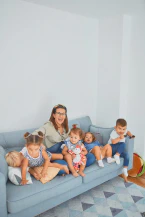Work-Family-Play Balance

The Power of Independent Play: Unlocking Creativity and Self-Expression
As parents, we often find ourselves searching for practical ways to encourage our children to play independently. It’s something that touches with many of us, including myself. I understand the challenges of balancing work and parenting while trying to create an environment where our kids can thrive.
I vividly remember feeling overwhelmed when my kids didn’t seem to engage in independent play. It was especially challenging in our small apartment where space was limited, and they would often end up fighting over toys. As a working parent, I struggled to find time to focus on my tasks while also attending to their constant needs.
But here’s what I’ve come to realize: independent play is not only crucial for our own sanity as parents, but it’s also an essential skill for our children. It provides them with a sense of autonomy and develops their imagination, creativity, and self-confidence. The benefits go beyond just keeping them occupied; it’s a valuable tool for their overall growth and well-being.
I’ve encountered countless parents facing similar struggles, and I empathize with the feeling of not having control over our children’s playtime. We may think that providing them with the latest toys or a dedicated playroom is the solution, but it doesn’t have to be that complicated or costly. In fact, you likely have everything you need right at home.
In my own experience, I discovered that fostering independent play doesn’t require a large budget or excessive amounts of space. It’s about creating intentional play zones within the existing environment. Even in a small apartment, you can designate specific areas for different types of play. It could be a corner for building blocks, a cozy reading nook, or a spot for art and creativity.
What amazed me was how my children hugged these play zones. Each child has their own unique temperament and interests, and by tailoring the play areas to their preferences, they were able to engage deeply and independently. It was as if they discovered a whole new world within our small space.
Now, I understand that every child is different, and each situation presents its own challenges. But the beauty of independent play is that it can be adapted to suit any child or home. It’s a skill that can be cared and grew, even if our circumstances or resources are limited.
I encourage you to take a closer look at your home and consider how you can create designated play areas that cater to your child’s interests. It doesn’t have to be elaborate; it’s about providing them with a safe and stimulating environment that encourages their imagination to soar.
Remember, independent play is not just a way to keep our children entertained—it’s a vital component of their development. It fosters their cognitive, emotional, and social skills while giving them a sense of accomplishment and self-reliance.
So, let’s hug the power of independent play and unlock the boundless creativity and self-expression within our children. With a little creativity, intentionality, and a willingness to let go of control, we can create a caring space that allows our kids to flourish. And the best part? You already have everything you need to get started.
Overcoming Challenges: Creating Play Zones in Small Spaces
Living in a small space can present unique challenges when it comes to providing an environment for our children to play and explore. I know this firsthand, as I recall the struggles I faced in my tiny apartment while trying to create engaging play areas for my kids. But with a little creativity and resourcefulness, it’s possible to overcome these challenges and foster a space that encourages independent play.
One of the first steps I took was to assess the available space and identify areas that could be repurposed for play. It was about making the most of what I had rather than focusing on what I lacked. By rethinking corners and nooks, I was able to carve out dedicated play zones within our small apartment.
For example, I transformed a corner of our living room into a cozy reading nook by adding a small bookshelf, some cushions, and a soft rug. This became the perfect spot for my children to indulge in their love for books and let their imaginations run wild. By designating this area solely for reading, it created a sense of purpose and excitement whenever they stepped into their little literary haven.
Another challenge I faced was finding space for building blocks and other constructive play activities. Instead of scattering toys all over the floor, I utilized a storage ottoman that doubled as a play surface. It provided a compact yet functional solution, allowing my kids to engage in building and imaginative play while also keeping the space tidy and organized.
I also realized the importance of outdoor play, even if I didn’t have a backyard or a large balcony. I made the most of the available outdoor space by utilizing nearby parks or even creating temporary play areas in open green spaces. These outdoor adventures not only provided a change of scenery but also offered valuable opportunities for physical activity, exploration, and socialization.
It’s important to note that creating play zones in small spaces isn’t just about designating areas—it’s also about decluttering and optimizing storage. I found that by regularly decluttering and organizing toys and materials, I was able to maximize the available space and create a more inviting play environment. Storage bins, hanging organizers, and vertical shelving became my allies in maintaining an organized and functional play area.
As I reflect on these challenges and how I overcame them, I realize that it’s not the size of the space that matters most—it’s the intentionality and thoughtfulness we put into creating engaging play zones. With a bit of creativity, we can transform even the tiniest of spaces into magical realms for our children to explore, learn, and grow.
So, if you find yourself facing the challenge of limited space, I encourage you to hug the possibilities. Look beyond the physical constraints and rethink your home as a place of wonder and discovery. By repurposing corners, decluttering, and optimizing storage, you can create play zones that cater to your child’s interests and provide endless opportunities for independent play.
Remember, it’s not about the size of the space, but the love and care you put into caring your child’s imagination and creativity. So, let your small space become a canvas for big adventures and watch as your children’s play flourishes in unexpected ways.
From Overwhelm to Joy: How Present Play Transformed My Parenting
Parenting can be a whirlwind of emotions, from immense love and joy to moments of overwhelming stress and exhaustion. I can relate to these ups and downs, and I’d like to share how the concept of Present Play transformed my experience as a parent and brought newfound joy into our lives.
Before discovering Present Play, I often found myself feeling overwhelmed and unsure of how to effectively engage with my children. The constant demands of work and daily life left me feeling drained, and I struggled to find the balance between meeting their needs and tending to my own.
But then, I stumbled upon the idea of Present Play, and it was like a breath of fresh air. Present Play is about being fully present and engaged in the moment with your child, immersing yourself in their world of play and imagination. It’s about setting aside distractions and truly connecting with your child on their terms.
Implementing Present Play in my daily routine had a profound impact on both my children and myself. It allowed me to let go of the constant need to multitask and gave me permission to be fully present with my kids. I discovered that quality over quantity truly matters when it comes to parenting.
By being present and engaged during playtime, I noticed that my children’s joy and creativity soared to new heights. They thrived on my undivided attention and reveled in the freedom to explore and express themselves without the pressure of constant supervision. It was as if a whole new world of possibilities opened up for them.
Present Play also taught me the value of observing and understanding my children’s individual play styles and interests. Each child is unique, and by hugging their preferences, I was able to tailor their play experiences to their specific needs. This allowed them to dive deeper into their passions and grow their own sense of self-expression.
One of the most significant changes I experienced was the deepening bond between myself and my children. Through Present Play, I discovered new ways to connect and communicate with them. We laughed together, shared stories, and built memories that will last a lifetime. It created a safe and caring space for us to truly understand and appreciate each other.
Moreover, Present Play became a powerful tool for self-care and personal growth. By immersing myself in my children’s play, I rediscovered the joy and wonder of my own inner child. It reignited my imagination and reminded me of the importance of hugging playfulness in all aspects of life.
Incorporating Present Play into our daily routine was a game-changer. It shifted my perspective on parenting from one of overwhelming responsibility to one of joy, connection, and mutual growth. It reminded me that the most precious gift we can give our children is our undivided attention and presence.
So, if you’re feeling overwhelmed or disconnected as a parent, I encourage you to explore the magic of Present Play. Set aside distractions, hug the power of being fully present, and watch as the joy and connection unfold between you and your child. Together, you’ll embark on a journey of discovery, imagination, and shared moments that will create a lifelong bond.
Caring Independent Play: Strategies for Busy Parents
As parents, we often find ourselves juggling multiple responsibilities and struggling to find time for ourselves amidst the busyness of life. We want our children to engage in independent play, but how can we foster this sense of self-reliance while also managing our own commitments? Let me share some strategies that have worked for me, based on my experiences as a parent.
First and foremost, it’s crucial to create a supportive environment that encourages independent play. This means providing age-appropriate toys, materials, and open-ended activities that stimulate your child’s imagination and curiosity. By having a variety of play options readily available, you’re enabling your child to explore and entertain themselves without constant guidance.
Additionally, establishing a predictable routine can be immensely helpful in promoting independent play. When your child knows what to expect, they feel secure and confident in their ability to navigate their playtime. Consistency in daily schedules, including designated play periods, allows them to develop a sense of structure and independence.
It’s important to gradually increase the duration of independent play as your child grows. Start with short periods and gradually extend the time, giving them opportunities to build their concentration and creativity. Initially, they may seek your attention or express their desire to play together. Be patient and gently encourage them to explore their toys and activities independently. Over time, they will become more comfortable and engaged in solo play.
Setting boundaries and establishing clear expectations is another essential aspect of caring independent play. Communicate with your child that during independent playtime, they are responsible for engaging in activities on their own. Encourage them to problem-solve, make decisions, and seek their own entertainment. By doing so, you’re fostering their independence and critical thinking skills.
It’s worth noting that independent play doesn’t mean leaving your child completely alone. Regular check-ins and positive reinforcement are crucial. Acknowledge their efforts and accomplishments, praise their creativity, and show genuine interest in their play. This supportive presence reassures them that you’re still there for them while allowing them the space to explore and create on their own.
Another helpful strategy is rotating toys and activities. Rather than overwhelming your child with an abundance of toys all at once, introduce a few items at a time and periodically rotate them. This helps maintain their interest and keeps playtime fresh and exciting. It also prevents toys from becoming cluttered, allowing for better focus and engagement.
Lastly, lead by example. Children learn by observing and imitating their parents. If they see you engaging in your own independent activities, whether it’s reading, crafting, or pursuing your hobbies, they’ll be inspired to do the same. Show them that independent play is enjoyable and valuable, and they’ll be more likely to hug it themselves.
Remember, caring independent play is a gradual process that requires patience and consistency. It’s about enabling your child to explore their interests and creativity while also creating space for your own well-being. By implementing these strategies, you can grow a sense of independence in your child and find a better balance in your busy life as a parent.
So, hug the power of independent play and watch as your child’s imagination and self-reliance blossom. It’s a journey that benefits both them and you, allowing for growth, development, and cherished moments of shared joy.
Hugging the Benefits: Developmental Growth through Independent Play
Witnessing our children engage in independent play is a beautiful sight. It’s a moment when their imagination takes flight, and they immerse themselves in a world of their own creation. But did you know that independent play offers more than just entertainment? It plays a vital role in their developmental growth. Let me share some insights based on my experiences as a parent.
Independent play allows children to tap into their innate creativity and problem-solving skills. When they have the freedom to explore and experiment on their own, they develop critical thinking abilities as they navigate through various challenges. It’s during these moments of independent play that they learn to think outside the box and come up with their unique solutions.
Moreover, independent play cares a sense of self-reliance and confidence in children. As they make decisions, set goals, and overcome obstacles on their own, they develop a belief in their capabilities. This self-assurance extends beyond playtime and positively impacts their overall development. They become more independent, resilient, and better equipped to face real-life situations.
Engaging in independent play also sparks the development of language and communication skills. Children often engage in self-talk during play, which helps them practice their vocabulary, sentence structure, and storytelling abilities. It’s a natural and enjoyable way for them to enhance their language development while expressing their thoughts and ideas.
Independent play fosters emotional regulation and self-control. When children play independently, they have the opportunity to explore and manage their emotions in a safe environment. They learn to navigate through various feelings, express themselves, and find coping strategies. This emotional intelligence becomes an essential life skill, enabling them to navigate relationships and handle challenging situations effectively.
Physical development is another aspect that independent play contributes to. Whether it’s running, jumping, building, or engaging in imaginative play, children’s gross and fine motor skills are put to the test. They develop strength, coordination, and dexterity as they manipulate objects, balance, and engage in active play. These physical abilities lay the foundation for their overall motor skill development.
Independent play also promotes social skills and empathy. While it may seem counterintuitive, solitary play allows children to observe and understand the world around them. They learn to be considerate of others’ perspectives, negotiate roles and rules when engaging in pretend play, and develop a sense of empathy. These skills translate into better social interactions and relationships with their peers.
As parents, it’s essential to provide an environment that cares independent play. Offer a variety of toys, materials, and open-ended activities that stimulate their imagination. Create designated play areas and ensure they have unstructured time to explore and engage in self-directed play. Balancing structured activities with independent play allows for a well-rounded developmental experience.
Remember, independent play is not about disengaging as parents but about offering our children the space and freedom to grow. Encourage their curiosity, be present when needed, and provide gentle guidance when necessary. Hug the benefits that independent play brings to their developmental journey and watch as they flourish into confident, creative, and emotionally intelligent individuals.
So, let’s celebrate the power of independent play and the incredible impact it has on our children’s growth. Create an environment that fosters their independence, releases their creativity, and cares their overall development. Hug the benefits and enjoy the journey alongside your child as they embark on new adventures through the magic of independent play.
No More Excuses: Designing a Playful Environment with What You Have
Imagine creating a playful and engaging environment for your child without breaking the bank or needing a large space. It may seem like a daunting task, but let me share with you some insights and tips based on my experiences as a parent. With a little creativity and resourcefulness, you can design a delightful play area using what you already have at home.
First, take a look around your living space and identify areas that can be transformed into play zones. It could be a corner in the living room, a section of their bedroom, or even a small nook in the hallway. Don’t limit your imagination—think outside the box and utilize every inch of available space.
Next, declutter and organize your child’s toys and materials. Sort them into categories and determine what can be stored in each play zone. By keeping toys accessible and visible, you create an inviting and engaging environment that encourages independent play. Consider using bins, baskets, or shelves to keep everything tidy and within reach.
Now, let’s talk about the different types of play zones you can create. Start with a play zone focused on imaginative play. This can be a designated area with costumes, props, and a small stage where your child can release their creativity and embark on exciting adventures. Transform an old cardboard box into a spaceship or create a makeshift tent using blankets and chairs for a cozy camping experience.
Another play zone to consider is a sensory exploration area. Fill a tray or shallow container with materials like sand, water beads, or rice for tactile play. Add scoops, containers, and small toys to enhance the sensory experience. This type of play zone not only stimulates your child’s senses but also promotes fine motor skills and concentration.
Don’t forget to create a movement zone where your child can engage in physical activities. Clear a space for them to jump, dance, or practice their balancing skills. Use masking tape to create hopscotch or a balance beam on the floor. Consider setting up a mini basketball hoop or an indoor trampoline if space permits. These activities promote gross motor skills, coordination, and active play.
If you have limited space, don’t worry! You can design a play zone using vertical wall space. Install a chalkboard or whiteboard on one wall where your child can release their artistic talents. Hang a rope or ladder from the ceiling for a fun climbing experience. Utilize wall-mounted shelves or hanging organizers to store art supplies, puzzles, or small toys.
Remember, the key is to use what you already have creatively. Look for items around your home that can be repurposed for play. A coffee table can become a Lego building station, an old sheet can transform into a fort, and a stack of cushions can create a cozy reading nook. The possibilities are endless when you let your imagination run wild.
By designing a playful environment with what you have, you not only stimulate your child’s imagination and creativity but also foster their independence and joy in play. Hug the power of simplicity and show your child that play doesn’t have to be complicated or expensive. It’s about using their imagination, exploring their surroundings, and having fun in the process.
So, let go of any excuses and start designing your child’s playful environment today. Get creative, repurpose items, and create engaging play zones within the space you have. Watch as your child’s eyes light up with joy and wonder, knowing that you’ve created a magical world for them to explore and grow.
Enabling Your Child: Building Confidence and Skill through Independent Play
As parents, we often strive to provide our children with every opportunity to learn, grow, and succeed. We enroll them in various classes and activities, hoping to care their talents and abilities. However, there is one crucial aspect of development that sometimes gets overlooked: the power of independent play.
Independent play refers to the time when children engage in play without constant adult guidance or intervention. It’s when they have the freedom to explore their surroundings, use their imagination, and make their own decisions. While it may seem simple, independent play holds incredible benefits for our children’s confidence, skill development, and overall well-being.
When children engage in independent play, they become more self-reliant and confident in their abilities. They learn to solve problems, make choices, and take ownership of their play experiences. This sense of autonomy fosters a strong sense of self and enables them to tackle challenges with toughness and creativity.
Through independent play, children also develop essential skills across various domains. Their cognitive abilities are enhanced as they engage in imaginative play, creating scenarios and solving problems within their make-believe worlds. They learn to think critically, develop logical reasoning, and explore cause-and-effect relationships.
Furthermore, independent play supports the development of language and communication skills. Children engage in conversations with their dolls, stuffed animals, or even imaginary friends, which helps them practice their vocabulary, sentence structure, and storytelling abilities. They learn to express their thoughts and emotions, building a foundation for effective communication.
Not only does independent play stimulate cognitive and language development, but it also promotes emotional and social growth. When children engage in unstructured play, they learn to navigate social interactions, negotiate, and cooperate with others. They develop empathy, emotional regulation, and conflict resolution skills, all of which are essential for healthy relationships and emotional well-being.
It’s important to note that independent play doesn’t mean leaving children completely unsupervised. As parents, we still need to ensure their safety and provide a supportive environment. However, allowing them the freedom to explore and create without constant adult direction fosters their sense of independence and self-expression.
Creating an environment conducive to independent play is key. Ensure your child has access to a variety of age-appropriate toys, books, and materials that spark their interests. Designate a specific play area where they can freely engage in activities without distractions. Encourage open-ended play experiences that stimulate their imagination and creativity, such as building blocks, art supplies, or nature exploration.
As parents, we can also be mindful of striking a balance between structured activities and independent play. While extracurricular classes and organized sports are beneficial, allowing time for unstructured play is equally important. Finding the right balance ensures that children have opportunities for both guided learning and self-directed exploration.
So, as you witness your child engrossed in their own world of play, take a step back and appreciate the immense value of independent play. Hug it as a powerful tool for enabling your child, building their confidence, and caring their skills. Provide them with a supportive environment, encourage their imagination, and watch as they flourish into resilient, creative, and confident individuals.
Remember, independent play is not just a way to keep children entertained—it is a foundation for their growth, development, and self-discovery. So, let’s prioritize independent play and give our children the space and freedom they need to thrive.
Finding Balance: Juggling Work, Family, and Quality Playtime
In today’s fast-paced world, many parents find themselves caught in the never-ending juggle of work, family responsibilities, and quality time with their children. We want to provide for our families and excel in our careers, but we also want to be present and engaged with our children. Finding the balance between these demands can be challenging, but it is crucial for the well-being of both parents and children.
As a parent who has faced this juggling act, I understand the struggle of trying to meet the demands of work while still making time for meaningful play experiences with my children. It often feels like there are not enough hours in the day to accomplish everything. However, I have learned that with intentional planning and prioritization, it is possible to strike a balance that allows for quality playtime with our little ones.
One of the first steps in finding this balance is setting clear boundaries between work and family time. Establishing dedicated periods for work and uninterrupted playtime can help create structure and ensure that both aspects of life receive the attention they deserve. This may involve setting specific work hours, creating a designated workspace, and communicating expectations with your employer or colleagues.
Another essential aspect is making the most of the time you do have with your children. Quality playtime doesn’t necessarily require hours of undivided attention; it’s about making the most of the moments you are present. Even short bursts of focused play can have a significant impact on your child’s well-being and strengthen your bond with them.
During playtime, prioritize activities that foster connection and engagement. Put away distractions like phones or laptops and give your child your undivided attention. Engage in activities that allow for open-ended play, where your child can take the lead and express their creativity. Whether it’s building with blocks, having a tea party, or exploring nature, these moments of shared play can be precious and memorable.
It’s also important to remember that quality playtime doesn’t always have to be elaborate or planned. Hugging spontaneous moments of play throughout the day can be just as meaningful. It could be a silly dance party in the living room, playing make-believe during bath time, or even engaging in a playful conversation during mealtime. These small bursts of playfulness can bring joy to both you and your child.
As parents, we must also prioritize self-care and recognize our own limitations. Taking care of ourselves allows us to show up fully for our children during playtime. It’s okay to ask for help when needed, whether it’s from a partner, family member, or trusted caregiver. Finding moments for self-care, whether it’s reading a book, going for a walk, or pursuing a hobby, rejuvenates us and enables us to be more present and engaged when we do spend time with our children.
Lastly, be gentle with yourself and let go of perfectionism. We all have days when work demands more of our time or when life throws unexpected curveballs. It’s essential to be flexible and adaptable, understanding that finding balance is an ongoing process. Hug the imperfections and focus on the moments of connection and joy you can create within the constraints of your busy schedule.
Remember, the key is to find a balance that works for you and your family. It may require some trial and error, but with perseverance and intentionality, you can create a harmonious blend of work, family, and quality playtime. Cherish the moments you have with your children, and celebrate the small victories along the way. The juggle may be challenging, but the rewards of meaningful playtime with your little ones are truly priceless.
Conclusion
Finding balance between work, family, and quality playtime is an ongoing journey that many parents face. It requires intentional effort, prioritization, and flexibility. While it may feel challenging at times, the rewards of meaningful playtime with our children are immeasurable.
By setting clear boundaries, creating dedicated periods for work and play, and making the most of the time we have, we can ensure that both our professional and parenting responsibilities are fulfilled. Engaging in quality playtime, whether it’s through structured activities or spontaneous moments of play, fosters connection, creativity, and overall well-being for both parents and children.
It’s crucial to prioritize self-care and seek support when needed, recognizing that we cannot pour from an empty cup. Taking care of ourselves enables us to show up fully for our children during playtime and strengthens our ability to handle the demands of work and family life.
Remember, finding balance is a continuous process, and it’s okay to have imperfect days. Hug the moments of joy and connection you create, and celebrate the small victories along the way. As parents, we have the power to care our children’s development, boost their confidence, and create lifelong memories through the power of play.
So, let’s hug the challenge, find harmony in the juggle, and prioritize quality playtime with our little ones. Together, we can create a caring and joyful environment where our children thrive, and our families flourish.
















